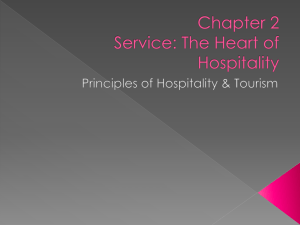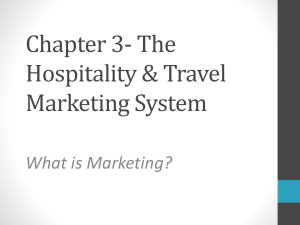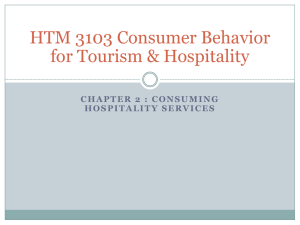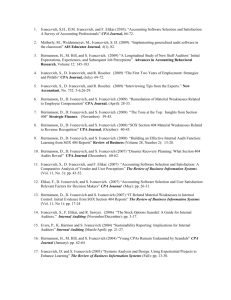Cultural diversity presentation in Hospitality Industry 3 ppt Final 24
advertisement
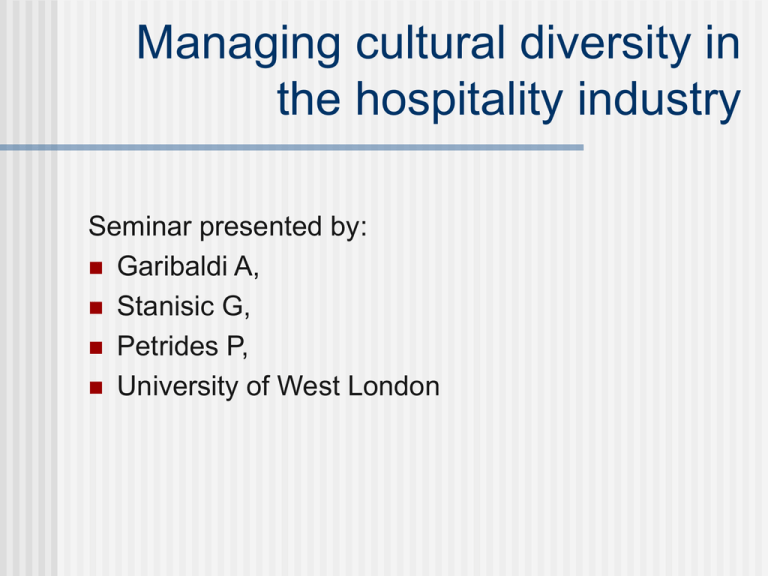
Managing cultural diversity in the hospitality industry Seminar presented by: Garibaldi A, Stanisic G, Petrides P, University of West London Introduction http://www.youtube.com/watch?v=ibQiyklq-Q. Objective of seminar To explore What is cultural diversity and how can it be effectively managed in the Hospitality Industry? Overview of seminar Section 1 – What is Culture and diversity Section 2 – What is cultural management Section 3 – Cultural diversity in the hospitality industry Section 4 – Legislation and policies relating to cultural diversity Section 5 – Hofstede’s Cultural dimensions theory Section 6 – The mosaic model by Kandola and Fullerton. Section 6 - Managing cultural diversity Section 7 - Cultural diversity and its benefits Section 8 - Challenges and issues with cultural diversity Section 9 – Conclusion and Questions ? Culture … that complex whole which includes knowledge, belief, art, law, morals, custom and other capabilities and habits acquired by man as a member of society. Taylor (1871) citied in Minkov (2011) Culture - human activity and symbolic structure designs that emphasize the importance and value of the actions. (Reisinger, 2009) Culture diversity management Culture diversity encompasses “… language, culture, race, nationality and religion” (Devine et.,2007:125) Effective managerial response to the challenges of managing increasingly diverse workforces (Gröschl, 2011) Cultural diversity in hospitality industry Migrant workers have formed a substantial part of the hospitality workforce in UK (Janta,2011). The growth of cultural diversity in the hospitality workforce results from a combination of global or international factors and conditions within the host country environment (Baum, 2007) Legislation and policies relating to the cultural diversity The Equality Act 2010 legally protects people from discrimination in the workplace and in wider society (UK Government, 2013) Hofstede,s cultural dimensions theory "Culture is the collective programming of the mind that distinguishes the members of one group or category of people from others“ Hofstede (2013) Hofstede,s cultural dimensions theory Hofstede 2013 Hofstede,s cultural dimensions theory Power Distance, Uncertainty Avoidance, Individualism versus Collectivism Masculinity versus Femininity Long Term versus Short Term Orientation Indulgence versus Restraint (Hofstede, Hofstede & Minkov, 2010) Kandola and Fullerton mosaic model Mission and values Objective and fair processes Skilled workforce: aware and fair Active flexibility Inclusive Culture that empowers Kandola (2006) Cultural diversity and its benefits Rise people interpersonal skills. Increases team-work. Expand innovative and creativity. Different attitudes and behaviors. Skills and variety of language spoken. Growth company credibility. Increases productivity on complex tasks. Divene et al 2007, Clements & Jones 2006, Peterson 2004, Sonnenschein 1997, Blair et al 2000 Challenge and issues with cultural diversity Communication. Commitment and loyalty. People perceptions of change. Complicates decision-making. Generate conflict. High employment turnover Discrimination and legal ramification. Baum et al 2006, Carr-Rufino 1999, Cox & Blakes 2001, French 2007, Holaday 2007, Schneider and Barsoux 2003, Wrench 2001, Managing cultural diversity Adopt an employee relationship management system. Overcoming stereotyping and discrimination. Training. Empowerment of individual. Appraisal and performance evaluation. Implementing and practicing cultural diversity policy. Equal treatment/treat people individually Groschl 2011, Ledwith & Seymour 2001, Madeira 2011, Maxwell et al 2000, Seymen 2006, Testa 2004, Wirth 2001 Conclusion & Question Diversity is an increasingly important component of the 21st century workplace. But putting these strategies into action, your organisation will be wellpositioned to leverage the power of difference. (Leondakis 2011) References Accor Hotels (2009), Workforce diversity, (online), Available from:< www.accorna.com/diversity/index.asp> (Accessed October, 2013) Baum, T. (2006). Human Resources Management for Tourism, Hospitality and Leisure: An International Perspective. London: Thomson Learning Chiavenato, P. (2005) The New Time for Administration. Expanding Knowledge in Cultural Diversity International Journal of Human Resource Management, Vol. 2, pp. 85. Devine, F., Baum, T., Hearns, N. and Devine, A. (2007) "Managing cultural diversity: opportunities and challenges for Northern Ireland hoteliers", International Journal of Contemporary Hospitality Management, Vol. 19 Iss: 2, pp.120 – 132 Dubrin,P. and , Andrew.J. (2003) Fundamentals organisational behavior. S/L: Cengage Worldwide Hospitality and Tourism Themes, Vol. 5 Iss: 9, pp.38–42 Gröschl, S. (2011) "Diversity management strategies of global hotel groups: A corporate web site based exploration", International Journal of Contemporary Hospitality Management, Vol. 23 Iss: 2, pp.224 – 240 Equality Act 2010: guidance (online) Available from: <https://www.gov.uk/equality-act2010-guidance>. (Accessed on October 2013) Hanashiro, D and Carvalho, F.P. (2008) Cultural diversity: an overview and reflections for the European reality, Ed. 47, Vol. 11 No. 5. Hearns N.,Devine F.,Baun T (2007)The implications of contemporary cultural diversity for the hospitality curriculum, Education and Training Vol. 49 No. 5, 2007,pp. 350-363, Emerald Group Publishing Limited Madera, J.M. (2011) "Removing communication barriers at work: What workforce diversity means for the hospitality industry", Worldwide Hospitality and Tourism Themes, Vol. 3 Iss: 4, pp.377 – 380 Maxwell, G., McDougall, M. and Blair, S. (2000) "Managing diversity in the hotel sector: the emergence of a service quality opportunity", Managing Service Quality, Vol. 10 Iss: 6, pp.367 – 373 Melia, D.M. and Kennedy, E. (2005), Cultural Diversity: A Management Perspective, Dublin Institute of Technology, Dublin. Okoro, E. & Washington, M. 2012. Workforce Diversity and Organizational Communication: Analysis of Human Capital Performance and Productivity. Journal of Diversity Management. Vol. 7 No 1. Seymen, O. A. (2006) "The cultural diversity phenomenon in organisations and different approaches for effective cultural diversity management: a literary review", Cross Cultural Management: An International Journal, Vol. 13 I: 4, pp.296 – 315



